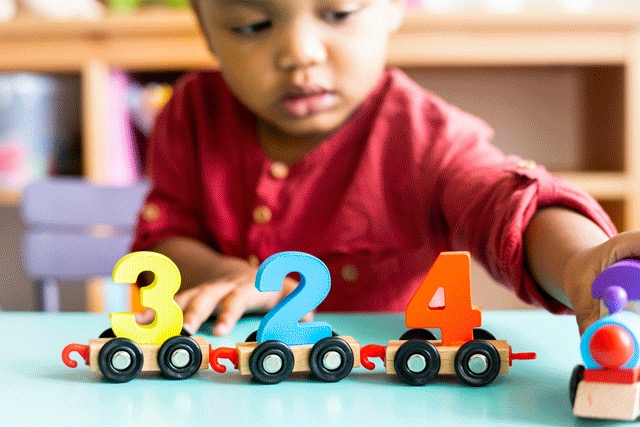One, two, three! Hearing young children begin to count is exciting! As families and caregivers listen to a child’s little voice say number words in order, they feel pride and joy in the child’s learning.
Saying the numbers in order, or rote counting, is a very useful and important skill. Children learn the patterns of number words as they rote count. They think about how a group of objects or individuals can be described using a number quantity. Children learn to rote count through songs, finger plays, stories, and by hearing the people around them count.
Rote counting is often the first time that families notice their child using “math.” Counting is one of the big math concepts young children explore, but not the only one! Math learning in early childhood includes many other concepts, skills, and understandings that children learn through their everyday exploration, routines, and play.
Sometimes, educators call this type of play mathematizing. By mathematizing, we mean using mathematical thinking and talk during play or routine activities. Here are a few examples about how young children might mathematize:
- Children notice when piles of toys or other objects have more or less pieces. For example, a child may notice when his peer has more toy animals than he does.
- Children use their fingers to count while singing songs such as “Five Green and Speckled Frogs” or “Five Little Ducks.” They may be eager to show their caregivers how many fingers they are still holding up after they finish singing a verse of the song.
- Children categorize toys, natural objects, and foods into groups. For example, they may sort dry cereal, fruit salad, or candies by color or shape.
- Children talk about whether something is longer, shorter, bigger, or smaller. For example, they may compare the length of their hair, the size of their feet, or their height to another person’s.
- Children talk about the passing time and what they will do next. For example, they may talk about games they played yesterday and places they hope to go tomorrow.
- Children notice colors and shapes. For example, children may comment about the colors and shapes of tiles in a hallway. They might try to walk on only a certain color or shape as they move down the hall.
Adults can help young children mathematize throughout the day. Adults can ask children questions about quantities, patterns, time, and shapes. They can encourage them to find out more about the world around them and provide tools such as tape measures, rulers, strings, or blocks for measurement. They can provide boxes and containers that encourage children to sort and classify objects.
Each time an adult encourages a child to mathematize, they are helping the young children they care about to develop mathematical thinking skills that will help them succeed in school.
Our team at the Illinois Early Learning Project has created four graphic Tip Sheets that contain ideas to help you encourage children to mathematize (Counting Up, Down, and All Around; Discover Shapes in Many Places; Making Sense of Numbers; Sorting, Classifying, and Organizing). These Tip Sheets have everyday examples of things you can do and say to encourage children to think mathematically. We hope you will use them and share them with others who support young children’s learning.

Rebecca Swartz
Dr. Rebecca Swartz is an assistant professor in the Department of Teaching and Learning at Southern Illinois University Edwardsville. She teaches courses in the early childhood education program including courses on early language and literacy, early mathematics, and collaboration with families. Prior to coming to SIUE she was an early learning specialist on state early childhood projects in the Department of Special Education at the University of Illinois at Urbana-Champaign.
Biography current as of 2022
IEL Resources
- Resource List: Math for Preschoolers


